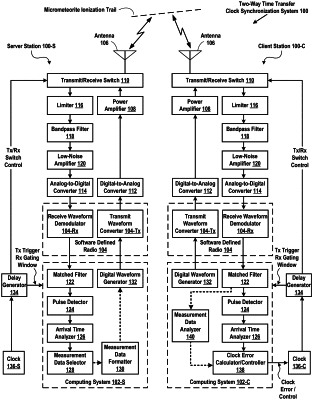| CPC H04W 56/005 (2013.01) [H04B 7/145 (2013.01); H04W 56/0015 (2013.01)] | 20 Claims |

|
1. A client clock synchronization system (CSS) configured for communications with a server CSS over micrometeorite ionization trail (MMIT) channels, the client CSS comprising:
an antenna;
a transceiver coupled with the antenna and configured for switching between transmit and receive modes; and
a computing system coupled with the transceiver and with a client clock, and configured for carrying out operations including:
via the antenna, with the transceiver in transmit mode, transmitting a sequence of radio-frequency (RF) pulses to the server CSS over a first multiplicity of MMIT channels, wherein transmission information indicating a respective local transmit identifier and respective transmission time of each transmitted RF pulse is maintained at the client CSS;
via the antenna, with the transceiver in receive mode, receiving a first plurality of RF pulses from the server CSS over a second multiplicity of MMIT channels, each received RF pulse consecutively following one of the transmitted RF pulses of the sequence, wherein reception information indicating a respective local receive identifier and arrival time of each received RF pulse is maintained at the client CSS;
via the antenna, with the transceiver in receive mode, receiving measurement data from the server CSS over a third multiplicity of MMIT channels, wherein the measurement data comprise, for each of a second plurality of RF pulses received by the server CSS, a respective remote receive identifier, a respective arrival time at the server CSS, and a respective signal-to-noise (SNR) measurement;
correlating the measurement data with the transmission information to identify respective transmitted RF pulses of the sequence with respective RF pulses of the second plurality received by the server CSS at the respective arrival times with the respective SNR measurements;
correlating the transmission times of the identified respective transmitted RF pulses with the reception information to determine a third plurality of respective RF-pulse pairs, wherein each respective RF-pulse pair comprises (i) a particular transmitted RF pulse that was received by the server CSS over a particular MMIT channel and (ii) a particular RF pulse that was received from the server CSS over the same particular MMIT channel and consecutively following transmission of the particular transmitted RF pulse;
applying two-way time transfer (TWTT) analysis to timing data of each RF-pulse pair to compute a set of time offsets of the client clock with respect to a server clock of the server CSS; and
applying an analytical model of clock drift to the set of time offsets to synchronize the client clock with the server clock.
|